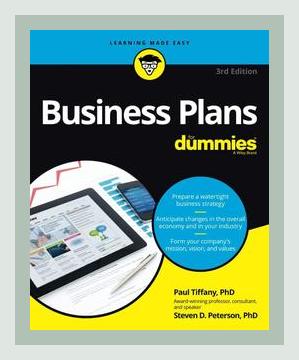Entrepreneurship and StartupsBusiness Planning
Title: Business Plans For Dummies (2014)
Authors: Paul Tiffany & Steven Peterson
Category: Business Planning
Introduction
“Business Plans For Dummies” by Paul Tiffany & Steven Peterson is a comprehensive guide to crafting a business plan that serves as the blueprint for launching a successful business. Through detailed explanations, real-world examples, and step-by-step instructions, the book ensures readers not only understand the components of a business plan but also how to effectively implement each aspect. This summary highlights the key elements of the book, providing concrete examples and specific actions to take.
Understanding Business Plans
Major Point: Importance of a Business Plan
A business plan is essential for setting goals, securing funding, and managing business growth. It not only maps out the business’s direction but also helps communicate the vision to stakeholders.
Action: Clearly define your business idea with a mission statement.
Example: John plans to launch a local vegan bakery. His mission statement is: “To provide delicious and healthy vegan baked goods using locally sourced ingredients to promote a sustainable lifestyle.”
Components of a Business Plan
1. Executive Summary
Major Point: Creating a Captivating Executive Summary
The executive summary should encapsulate the essence of the business plan, including the business concept, financial features, financial requirements, current business position, and major achievements.
Action: Write a concise, compelling summary that grabs attention.
Example: Lisa develops a pet care service and drafts an executive summary highlighting her unique mobile grooming unit, the rapid growth in the pet care industry, and her projected break-even in six months.
2. Business Description
Major Point: Detailed Business Description
This section includes the business name, location, type of business, the nature of the operations, and who the customers are.
Action: Outline the fundamental aspects of your business clearly.
Example: Alex describes his online custom t-shirt store, noting its e-commerce platform, target audience comprising millennials and Gen Z, and his niche in offering eco-friendly apparel.
3. Market Analysis
Major Point: Conducting Thorough Market Research
Understanding the market landscape involves analyzing the industry, target market, competition, and regulatory environment.
Action: Use surveys, interviews, and reports to gather data on your target market and competition.
Example: Maria researches the organic skincare market by reviewing industry reports, conducting customer surveys, and analyzing competitors’ pricing and product offerings.
4. Organization and Management
Major Point: Structuring Your Organization
This section covers the business’s organizational structure, details about the ownership, the management team, and the board of directors if applicable.
Action: Develop an organizational chart and define roles and responsibilities.
Example: Raj includes an organizational chart in his restaurant business plan showing himself as CEO, his sister as CFO, and an experienced chef as the head of kitchen operations.
5. Sales and Marketing Strategy
Major Point: Crafting Effective Sales and Marketing Plans
Well-crafted sales and marketing plans are essential for reaching your target audience and generating sales.
Action: Develop a marketing plan that includes pricing, advertising, and distribution strategies.
Example: Sarah outlines her marketing strategy for a digital marketing agency, detailing her approach to SEO, social media campaigns, and client workshops to convert leads into clients.
6. Product Line or Services
Major Point: Detailing Products and Services
Clearly describe your products or services, including their lifespan, benefits, and how they meet market needs.
Action: Create detailed product descriptions and highlight their competitive advantages.
Example: Ben lists his health coaching service packages, detailing programs for weight loss, muscle gain, and holistic wellness, and emphasizing personalized meal plans and 24/7 support.
7. Funding Request
Major Point: Articulating Financial Needs
If seeking funding, specify the amount needed, prospective uses of the funds, and potential future financial plans.
Action: Clearly state the funding requirements and intended uses.
Example: Emily requests $200,000 for her tech startup to cover software development, marketing, and initial operational costs, providing a timeline for usage and expected results.
8. Financial Projections
Major Point: Presenting Financial Projections
Include income statements, cash flow statements, and balance sheets for the next three to five years. Explain assumptions used for projections.
Action: Develop realistic financial projections and justify your assumptions.
Example: Tom assumes a steady 10% monthly growth rate in his SaaS business revenues due to effective marketing strategies and increased customer retention.
9. Appendix
Major Point: Including Supporting Documentation
The appendix can house additional information, such as resumes, product images, legal agreements, and market research data.
Action: Compile relevant documents that support your business plan assertions.
Example: Olivia includes product prototypes, detailed resumes of key team members, and market survey reports in the appendix of her business plan for an innovative kitchen appliance.
Practical Examples and Applications
Major Point: Real-World Case Studies
Integrating real-world examples within the chapters helps illustrate the principles discussed.
Action: Learn from the case studies provided and apply similar strategies.
Example: A case study of a successful online retailer emphasizes the importance of a comprehensive digital marketing strategy, which inspired Jake to enhance his social media presence and SEO efforts.
Adapting to Changes
Major Point: Flexibility in Business Planning
Business environments evolve, and so should your business plan. Regular reviews and updates ensure the plan remains relevant.
Action: Schedule quarterly reviews of your business plan to adapt to market changes and business growth.
Example: Chloe reviews and updates her business plan every quarter to incorporate changes in the fashion industry and adapt her online boutique strategies accordingly.
Conclusion
Major Point: Summing up the Business Plan Creation Process
A well-structured business plan is crucial for steering a business towards success, attracting investors, and guiding day-to-day operations.
Action: Follow the structured approach outlined in the book to create or revise your business plan.
Example: Mark used the book to overhaul his small manufacturing business plan, resulting in clearer goals, improved financial management, and successful investor pitches.
By implementing the detailed guidance and practical examples provided in “Business Plans For Dummies,” aspiring entrepreneurs and business owners can develop robust, actionable business plans that navigate their ventures toward sustained success.
